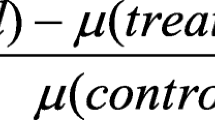Abstract
The pulse-amplitude-modulation (PAM) fluorometric method was used in the past as a sensitive and rapid method for assessing toxic effect of pollutants in plants. Here, we used the advantages of this method to evaluate the difference in sensitivity of Chlorella vulgaris, Selenastrum capricornutum, and Chlamydomonas reinhardtii to copper toxicity. We found by using the PAM-fluorescence parameters (φM, φ′M, QP, and QN), that C. reinhardtii is the most sensitive species, followed by S. capricornutum and C. vulgaris. Indeed, the copper 5-, 48-, and 96-h EC50 for φM, φ′M, and QP vary between 11 and 34 μg/L for C. reinhardtii, while for S. capricornutum this value is between 25 and 50 μg/L. However, the same parameters obtained from C. vulgaris did not show susceptibility to copper, even at very high concentrations (100 μg/L). In this study, the estimated 5-h EC50 for C. reinhardtii and S. capricornutum are lower than the 24-h EC50 reported earlier for these species with other bioassays, indicating that the use of PAM fluorometry in copper bioassay provides a more sensitive method than the other biotests in aquatic toxicology.
Similar content being viewed by others
Author information
Authors and Affiliations
Additional information
Received: 31 December 2000/Accepted: 5 August 2001
Rights and permissions
About this article
Cite this article
Juneau, P., El Berdey, A. & Popovic, R. PAM Fluorometry in the Determination of the Sensitivity of Chlorella vulgaris, Selenastrum capricornutum, and Chlamydomonas reinhardtii to Copper. Arch. Environ. Contam. Toxicol. 42, 155–164 (2002). https://doi.org/10.1007/s00244-001-0027-0
Issue Date:
DOI: https://doi.org/10.1007/s00244-001-0027-0




